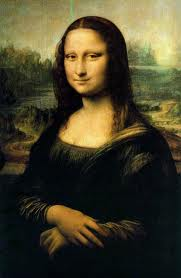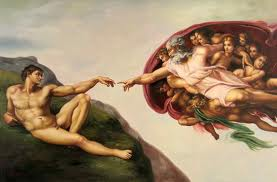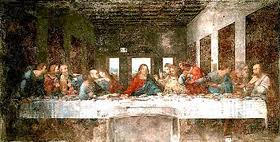The artists Leonardo da Vinci and Michelangelo Buonarroti are famous for their great artistic pieces of work during the renaissance period. This paper will focus on analyzing the different styles of painting in the paintings Mona Lisa and The Last Supper by Leonardo da Vinci and The Creation of Adam by Michelangelo Buonarroti.
Mona Lisa by Leonardo da Vinci
The portrait of Mona Lisa which is also referred to as “La Gioconda,” “wife of Francesco Del Giocondo,” or “Portrait of Lisa Gherardini” was done by an Italian artist by the name Leonardo da Vinci (Da Vinci, 2008). The painting was done on a poplar panel using oil paint in the years 1503 to 1519. The Mona Lisa painting is the most celebrated and famous work of all time. Leonardo da Vinci demonstrates mastery in art as evidenced by the portrait’s subtle detail especially the distinctive gaze of the woman accompanied by a faint smile.
Leonardo da Vinci was born in Florence, Italy to a peasant father Piero da Vinci and mother Catarina. He was educated in an arts studio owned by Verrocchio, a Florentine painter. He is said to have been commissioned by Francesco Del Giocondo to paint the portrait of his wife and this is how the Mona Lisa painting came about. The painting is a portrait of a woman sitting upright with the arms folded showing that her posture was a reserved one (Kemp, 2006).
Her gaze seems to be fixed on the observer demonstrating Leonardo’s Gombrich and Sfumato styles of painting. Sfumato, Chiaroscuro, and Gombrich are techniques where colors are softened and dark glazes are used to do the edges; it is the use of the smoky colors and somber mood to do a painting (Da Vinci, 2008). The painting style fits the time period of renaissance in Italy when painting was done by concentrating on light and shade.

The Creation of Adam by Michelangelo Buonarroti
The painting the creation of Adam was done as a section of the Sistine chapel ceiling by Michelangelo in the year 1511. The painting is said to illustrate the “Biblical story of creation where God breathes life to Adam as the first man.” Chronologically, this painting was the fourth to be done in a series which depicted the episodes of creation from the book of genesis done on the Sistine chapel.
Michelangelo Buonarroti was born in Caprese, Tuscany Italy in the year 1475 and grew up as a sculptor, painter, and architect. He is famously known for having frescoed the portraits including the Creation of Adam on the ceiling of the Sistine chapel.
The creation of Adam portrait was commissioned to be done by the Pope and it focuses on the two main characters which are Adam and God. God is demonstrated as bearded man in a loose robe trying to reach out to a naked man on the left corner, probably Adam.
The image shows an outstretched right arm of God with a finger pointing to Adam and Adam’s left arm outstretched to mirror God. Both God’s and Adam’s fingers are not touching giving the impression that, “God is the giver of life and Adam is reaching out to receive it” (Meshberger, 1990).
Michelangelo used the style of figurative and mannerist painting to complete the fresco and depict the divine dynamism. This painting was done using oil and tempera to bring out the mannerist and figurative styles of painting; oil was applied in successive tones by using intense color and then light one (Salcman, 2006).
Color effect demonstrated by this tempera painting demonstrates Michelangelo’s Cangianti unique style of painting. The painting was done during the Italian renaissance thus fits well for the time period it was created.

The last supper by Leonardo da Vinci
This painting is of a mural nature and it was done in the 15th century by Leonardo for Duke Sforza and Beatrice d’Este. The painting represents “the scene of The Last Supper” when Jesus was ending his mission as told in the Biblical book of Luke (Kemp, 2006). The painting is large such that it covers a whole wall of Santa Maria delle grazie dining hall situated in Milan, Italy.
The painting is done on a wall that is dry instead of a wet plaster thus its not fresco. The painting was done using the mural style and not fresco to allow Leonardo the freedom of experimenting. He used the tempera technique by mixing vinegar and egg yolks and oil paint as well. To seal this layer of tempera, Leonardo sealed the wall using pitch as well. The painting was done between 1495 and 1498 thus fits well to the rebirth period of time (Kemp, 2006).

The three paintings, Mona Lisa, The Last Supper, and The Creation of Adam were painted during the period of rebirth or renaissance. In these paintings both Leonardo da Vinci and Michelangelo used “realistic painting techniques accompanied by classical compositions” (Leslie, 2007).
These pieces of art mark the shift from classical themes to antiquity themes which infuse realism (Da Vinci, 2008). The renaissance period demonstrated a technical achievement in that the artists used oil paints that allowed mixing of colors due to their extended time of drying such that they could add some elements to their compositions.
These three paintings have different art elements including line, shape, and color, and value, principles of design such as contrast, pattern, and balance. In the Mona Lisa painting, Leonardo employs the Sfumato and Gombrich styles of painting which gives the painting the smoky effect (Leslie, 2007).
This effect means that the painting does not have borders or lines just like smoke. The painting is a portrait of a woman with a faint smile and a fixed gaze. This is a beautiful painting which combines excellent painting techniques.
In the painting “The Creation of Adam,” Michelangelo uses the mannerism and figurative style of painting to demonstrate divine dynamism in this fresco (Chapman and Buonarroti, 2005). He used oil and tempera to apply successive tones using intense colors and then lighter ones.
Leonardo used the mural painting style to do this large painting which actually covers an entire wall. He used a dry wall to paint meaning that he had the freedom to experiment and add some elements with time. Tempera technique is evident where he used oil paint and mixtures of vinegar and egg yolks.
Conclusion
Mona Lisa, the creation of Adam, and the last supper paintings by Leonardo da Vinci and Michelangelo Buonarroti are some of the famous pieces of art of all time. These paintings were done during the renaissance period in Italy and they incorporate different styles of painting. These renowned artists employed different styles like Sfumato, Gombrich, mannerist, and figurative, as well as Cangianti painting styles. These three paintings have different symbolic significance and different points of view of the artists.
References
Chapman, H. and Buonarroti, M. (2005). Michelangelo drawings: closer to the master. USA: Yale University Press.
Da Vinci, L. (2008). Mona Lisa. France: Mus{\’e}e du Louvre, Paris.
Kemp, M. (2006). Leonardo da Vinci: the marvelous works of nature and man. USA: Oxford University Press, USA.
Leslie, L. (2007). Auto-annotation of paintings using social annotations, domain ontology and transductive inference. Advances in Multimedia Information Processing, 1 (12), 266-275.
Meshberger, F.(1990). An interpretation of Michelangelo’s Creation of Adam based on neuro-anatomy. JaMa, 264 (14), 1837-1841.
Salcman, M. (2006). The Creation of Adam by Michelangelo Buonarroti (1475-1564). Neurosurgery, 59 (6), 11.